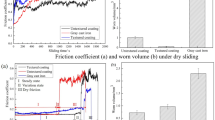Abstract
Self-lubricating materials are a broad class of compounds featuring the incorporation of one or more solid lubricants, leading to decreased friction and wear during sliding contact. In our contribution, we devote our effortton the development of self-lubricating metallic alloys for laser deposition processes. Laser deposition processes, such as laser metal deposition or direct energy deposition, are additive manufacturing techniques that offer a great flexibility and efficiency compared to traditional subtractive manufacturing processes. However, the extreme thermal conditions experienced during deposition in addition to rapid cooling pose great challenges for alloy design. This contribution illustrates these challenges by means of self-lubricating iron and nickel-base alloys incorporating lubricious soft metals and metal sulfides. Their microstructure and phase composition are characterized using X‑ray diffraction in addition to scanning and transmission electron microscopy, showing the importance of having the soft metal as single phase without forming intermetallic compounds or being in solid solution. Afterwards, their friction and wear performance are evaluated by using high temperature tribological tests in air and vacuum. The results reveal that the self-lubricating laser deposited alloys are able to control friction from room temperature to 600 °C in ambient air and at least until 300 °C in vacuum.
Zusammenfassung
Bei selbstschmierenden Werkstoffen handelt es sich um eine breite Klasse von Verbindungen, in die ein oder mehrere Festschmierstoffe eingearbeitet sind, was zu einer Verringerung von Reibung und Verschleiß beim Gleitkontakt führt. In unserem Beitrag widmen wir uns der Entwicklung von selbstschmierenden metallischen Legierungen für Laserauftragsverfahren. Laserdepositionsverfahren wie Laser Metal Deposition oder Direct Energy Deposition sind additive Fertigungsverfahren, die im Vergleich zu traditionellen subtraktiven Fertigungsverfahren eine große Flexibilität und Effizienz bieten. Die extremen thermischen Bedingungen während der Abscheidung und die schnelle Abkühlung stellen jedoch eine große Herausforderung für das Legierungsdesign dar. Diese Arbeit veranschaulicht diese Herausforderungen anhand von selbstschmierenden Eisen- und Nickelbasislegierungen, die schmierfähige Weichmetalle und Metallsulfide enthalten. Ihre Mikrostruktur und Phasenzusammensetzung werden mit Hilfe von Röntgenbeugung sowie Raster- und Transmissionselektronenmikroskopie charakterisiert, wobei sich zeigt, wie wichtig es ist, dass das Weichmetall einphasig ist und keine intermetallischen Verbindungen bildet oder in fester Lösung vorliegt. Anschließend wird das Reibungs- und Verschleißverhalten mit Hilfe von tribologischen Hochtemperaturtests an Luft und im Vakuum bewertet. Die Ergebnisse zeigen, dass die selbstschmierenden, lasergeschichteten Legierungen in der Lage sind, die Reibung von Raumtemperatur bis 600 °C an Luft und mindestens bis 300 °C im Vakuum zu kontrollieren.








Similar content being viewed by others
References
Torres, H., Rodriguez Ripoll, M., Prakash, B.: Tribological behaviour of self-lubricating materials at high temperatures. Int. Mat. Rev. 63, 309 (2018)
Kirkhorn, L., Gutnichenko, O., Bihagen, S., Stahl, J.E.: Minimum quantity lubrication (MQL) with carbon nanostructured additives in sheet metal forming. Proc. Manuf. 25, 375 (2018)
Torres, H., Slawik, S., Gachot, C., Prakash, B., Rodriguez Ripoll, M.: Microstructural design of self-lubricating laser claddings for use in high temperature sliding applications. Surf. Coat. Technol. 337, 24 (2018)
Torres, H., Rodriguez Ripoll, M., Prakash, B.: Self-lubricating laser claddings for friction control during press hardening of Al-Si-coated boron steel. J. Mater. Process. Technol. 269, 79 (2019)
Torres, H., Caykara, T., Rojacz, H., Prakash, B., Rodriguez Ripoll, M.: The tribology of Ag/MoS2-based self-lubricating laser claddings for high temperature forming of aluminium alloys. Wear 442–443, 203110 (2020)
Torres, H., Rojacz, H., Čoga, L., Kalin, M., Rodriguez Ripoll, M.: Local mechanical and frictional properties of Ag/MoS2-doped self-lubricating Ni-based laser claddings and resulting high temperature vacuum performance. Mater Des 186, 108296 (2020). https://doi.org/10.1016/j.matdes.2019.108296
Torres, H., Caykara, T., Hardell, J., Nurminen, J., Prakash, B., Rodriguez Ripoll, M.: Tribological performance of iron-and nickel-base self-lubricating claddings containing metal sulfides at high temperature. Friction 10, 2069 (2022). https://doi.org/10.1007/s40544-021-0578-1
Qu, C.C., Li, J., Juan, Y.F., Shao, J.Z., Song, R., Bai, L.L., Chen, J.L.: Effects of the content of MoS2 on microstructural evolution and wear behaviors of the laser-clad coatings. Surf. Coat. Tech. 357, 811 (2019)
Torres, H., Pichelbauer, K., Budnyk, S., Schachinger, T., Gachot, C., Rodríguez Ripoll, M.: A Ni-Bi self-lubricating Ti6Al4V alloy for high temperature sliding contacts. Journal of Alloys and Compounds 944, 169216 (2023)
Funding
This work was funded by the Austrian COMET-Program (project K2 InTribology1, no. 872176) and has been carried out within the “Excellence Centre of Tribology” (AC2T research GmbH).
Author information
Authors and Affiliations
Corresponding author
Additional information
Publisher’s Note
Springer Nature remains neutral with regard to jurisdictional claims in published maps and institutional affiliations.
Rights and permissions
About this article
Cite this article
Rodríguez Ripoll, M., Torres, H. & Gachot, C. Microstructural Design of Self-lubricating Metals for Forming Processes and Aerospace Applications Using Laser Metal Deposition. Berg Huettenmaenn Monatsh 168, 254–258 (2023). https://doi.org/10.1007/s00501-023-01348-1
Received:
Accepted:
Published:
Issue Date:
DOI: https://doi.org/10.1007/s00501-023-01348-1




